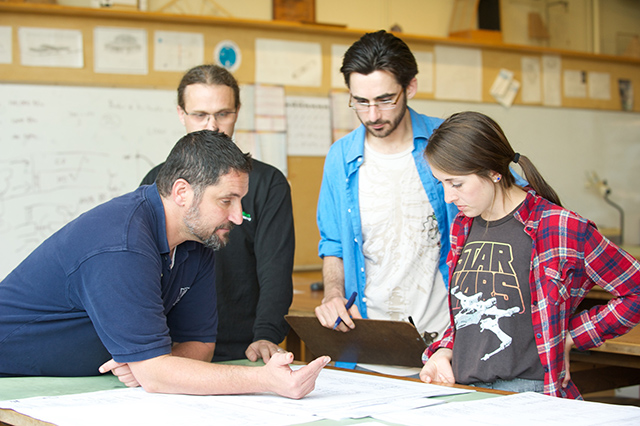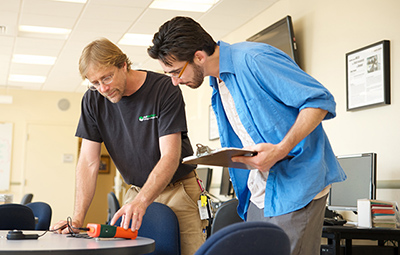
What’s up next for Founders and its cousin, Gist Hall, is an examination and reconditioning of what lies under the hood. For Arik Cohen (’97, Energy Resource Management and Applied Mathematics), the project has both professional and emotional significance.
“The point is to bring the buildings back to what the original design intended,” said Cohen, who is a principal engineer for Oakland-based kW Engineering, the firm contracted to test energy systems and make recommendations. “It’s like a car being out of tune. When you bring in your car for a tune-up, you check the air pressure in the tires, change the filters, etc., so it runs like it was intended when new. Of course, we incorporate current knowledge used on modern buildings to bring it up to date.”
As an alumnus, securing the contract was particularly appealing, Cohen said. “It was an extra incentive for me to work with my alma mater. That was a big selling point. I want to give back as much as I can to the university.”
Joining Cohen to collaborate on the project are two other Humboldt State graduates, Andy Sorter (’04, Environmental Resources Engineering), owner of Arcata-based ourevolution Engineering, and Scott Willits, (’99, Environmental Resources Engineering) staff engineer and thermographer for ourevolution. They also found special meaning in being involved.
“Working in the two oldest buildings on campus is very significant in terms of their historic nature,” Sorter said. “I can’t think of two more iconic structures on campus. Gist Hall was the teaching college which my father graduated from, and Founders Hall is the face of Humboldt State.”
Cohen's interest in the energy engineering field began in 1995 at Humboldt State’s Schatz Energy Research Center, where he was exposed to energy conservation and renewable energy technologies. His experience with the Schatz Lab represents another commonality among the project’s engineers. During their undergraduate years, both Willits and Sorter worked at the prestigious facility.
Adding another fresh element to the process of updating the past are a pair of current engineering students who worked closely with the alumni during the energy assessment. To Ryan Kaplan and Kaleigh Vincent-Welling, both of whom are enrolled in the Environmental Resources Engineering program, the experience provided a clear view of what lies beyond the classroom.
“I got to actually be there in the action, behind the scenes, and witness a project, one that could be similar to one I work on in the future,” Vincent-Welling said. “It was pushing out of the textbooks and in-lab work and truly seeing what was out there, what engineers do in the field. “

Much of the work involved dissecting systems in place, and as Sorter said, “looking at the mechanical room, looking at crawl space and in the attic.”
“Being Environmental Resources Engineering graduates, we know that, as a student, it is easy to get tunnel vision when it comes to the rigorous classroom training provided within the department,” Sorter said. “So getting out and getting your hands dirty is a great way of putting all of that training into perspective and helps the student realize that the core engineering skill set that they are mastering is designed to equip them to handle real world engineering challenges.”
In September, the team gathered to dissect the project and begin the assessment, one of nine phases of the step-by-step process. The students were assigned duties that included taking natural light readings and helping look for mechanical failures or inefficiencies with the heating and ventilation systems.
“For instance, there’s no outside air dampers in Gist Hall’s air distribution systems,” Cohen said. “We’ll assess the cost-benefit ratio of installing outside air dampers and come up with other ideas to save energy.”
Next up is analyzing the information the team gathered, checking the mechanical drawings, and narrowing down energy trends based on the new data. After determining how the systems are operating, Cohen, Sorter, and Willits will look at that information to form a plan of attack.
“The focus is retro-commissioning–taking what is already there and making it more efficient,” said Cohen. “What we do isn’t really apparent to the building occupants. The concept is getting the most out of what’s already in place.”
The end result will be measurable, however, in reduced energy-related costs and increased comfort for students, faculty and staff that occupy the buildings. Yet another outcome is the development of future alumni experts Kaplan and Vincent-Welling.
“Hands-on learning is an absolutely vital aspect of the education process,” Kaplan said. “Needless to say, this experience has inspired me. I feel excited about future possibilities, and I look forward to continuing to learn in order to meet the new challenges and unknowns I'll inevitably face in the working world. “